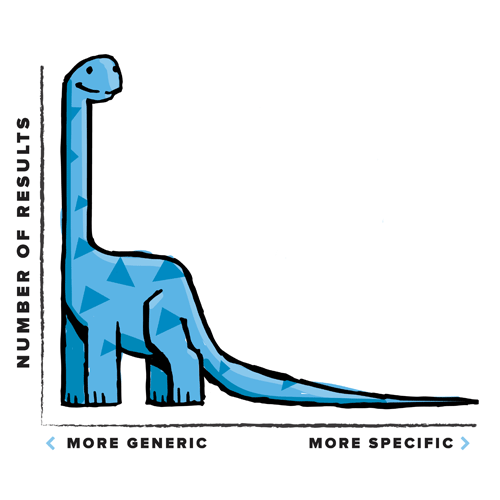The search engine optimization world is full of snake oil and tricks. Everyone wants to “get rich quick.” Problem is, that doesn’t work in the long term. Here’s how to build a sustainable SEO strategy that stands the test of time.
Let’s start our sustainable SEO journey with the nerdy stuff! Technical factors aren’t everything when it comes to SEO, but they do ultimately play a role. Remember, the only way to rank is to serve the best content in the world on a fast page that aligns with modern best practices.
Step 1: Run a test on web.dev/measure
This is a test using Lighthouse – an open-source, automated tool for improving the quality of web pages. You likely won’t be able to do much about this right now unless you’re a dev, but it gives a good first look at how Google sees you technically. Lots of green is good. Lots of red is, well, bad. That’s something we should look at.
Download this report (it’ll be a .html file) and stick it in your back pocket. Maybe share it with your web team or your developers.
That’s enough pure technical stuff for now. Now for content!
Step 2: Think about your users
Here’s the headline: SEO is not about you. It’s about how you want to find you.
Think about who you want reading your site. Then think about what they want day to day. What are their problems? What do they look for online? What makes someone or something authoritative to them?
(If you’ve developed buyer personas in the past, this is a great time to call them up.)
This isn’t about what you want to say to them. This is about getting your head in the right place to think about connecting with them. That’s the key to sustainable SEO, particularly for B2B.
Checklist for Step 2:
- What is your dream user? A CEO? A VP?
- What is your realistic user? This is probably someone lower down the ladder.
- What problems do you solve that they hit both day-to-day and in the big picture?
- What challenges related to your space do they hit both day-to-day and in the big picture? You needn’t solve these directly.
- What might they search for if they were looking for exactly what you do?
Step 3: Now look at your site.
Call up your homepage and have a look. Show it to a few other folks, too, if you can.
Is it obvious what you do? In other words, does the homepage scream – in a way your user understands – “THIS IS WHO WE ARE”?
Now imagine that the user from Step 2 Googles what you do. Say they’re looking for a contract research organization specializing in patient-centricity. They don’t know you from Adam, and they search for “patient-centric CRO.” If your homepage screams that you’re a patient-centric CRO and they find you, can you make an honest case that they’ve found the best possible answer to their query?
Forget your sales pitch.
This isn’t about your sales pitch. This is about how your site answers the user. If you’re looking for a patient-centric CRO, your search intent indicates that you probably want:
- To find a CRO to partner with,;
- That is devoted to a patient-centric approach.
How would you back this up on your website? How would you create the perfect answer to the user’s search intent? In this case, you’d almost certainly:
- Lead with the message of patient-centricity and what it means to your organization. That means you’re using those words – Google can only infer so much.
- Cite examples and experience; if someone is looking for a partner, they’re going to want to know they have the chops.
- Have a site that’s easy to navigate, simple to read and clear in its intent.
- House a fair bit of content around the topic of patient-centricity. This would likely include studies on the effect of remote visit services on patient recruitment and retention, thought leadership from your team on the benefits of the approach, best practices for driving a patient-centric approach into trials, etc.
- Make it really easy for the user to convert based on their intent; in this case, that’s likely submitting an RFP. (We call these calls to action.)
How do you stack up?
Can you truly and honestly say that you’ve stuck a flag in the ground to make it obvious who you are, built a site that backs it up, and delivered the ultimate result for someone looking for that?
Remember, sustainable SEO isn’t about your differentiators, campaigns or “what you want to say.” For search engine optimization purposes, it’s about making your site the perfect answer to a question someone asked Google. A sales pitch is almost never a perfect answer. If you deliver the content and the information that matches what they really want, they’ll come – and they’ll convert.
The same theory applies in microcosm to “interior” content, like pages on your discrete services, and even blog posts. Just like your site as a whole, every page or post needs to raise a flag as the perfect answer to something and have it backed up.
If you sell eRegulatory software, for example, you’re probably talking to a lot of CRCs. They might be out looking for best practices on document naming, or IRB approval filing. Answer those questions! When you do, you’re building a corpus of content that proves your authority and helps you better match search intent. This is called long-tail keywording.
Checklist for Step 3
- Do your homepage and major interior pages have obvious focuses?
- Does your content give the perfect answer to the intent of a search for that focus?
- How credible do you look qualitatively? You probably don’t take payments on your site, but if you did, would you feel comfortable giving your credit card over to it?
- Is it obvious that you’re an authority in your space? Or could you be anyone off the street?
Step 4: Make a long-tail content map
If your site is already perfect, you’re done. Bye.
If it isn’t – that is, you’re not providing the absolute best content in the world relating to the intent of the search queries of your dream and typical users – it’s time to map things out.
First, make a spreadsheet with three columns titled “Head,” “Body” and “Tail.”
Now Google the obvious “THIS IS WHAT WE DO” of your homepage. (For Altitude, for example, this is “marketing agency.”) Do you come up? If not, do companies similar to you?
If the top results are similar to you (or even competitors), you’re on the right track. If they’re not – say, Wikipedia and a bunch of academic papers – you need to reorient. What that means is that Google doesn’t see the intent of that search pertaining to someone like you. (For Altitude, this would be something like “marketing.” It’s too broad.) Try different wording, or getting a bit more specific, until you hit on a term that obviously describes you and returns similar solution providers.
Congratulations! You’ve found your first head keyword.
The goal of long-tail SEO is to support your head term by creating content “down the dinosaur.”

Head terms are your ideal. They’re the focus of your homepage and key interior pages. They’re relatively highly searched, and relatively broad.
- Put this first head term in A2 of your spreadsheet. Now move to B3. It’s time to create some body terms.
- Body terms support your head terms in sustainable SEO. They’re a little longer – say, “B2B marketing agency” as a body supporting “marketing agency” as a head. They add adjectives, specificity and description to your head term. In essence, what they’re doing is giving users and Google a fuller picture of who you are and what you do.
- Because they’re more specific, body terms are easier to rank for than head terms. You’ll show up on Page 1 for them before your head terms. You need to use them and support them throughout your site. Once you’ve made the case for enough, Google will be able to properly contextualize you and start looking at you for your heads.
Here’s an example
Altitude is a marketing agency. That’s our head term. It’s also wildly competitive. So to contextualize it (and get some smaller-scale wins), we support the head by making sure it’s obvious that we’re an authority as a:
- B2B marketing agency
- Technology marketing agency
- Life sciences marketing agency
Now do the same for yourself. Add more specific body terms in Column B next to the head term. Your content map will look like this:

At this stage, it’s very unlikely that your site is already a clear and obvious authority – the perfect answer – for all of your head and body terms. This is where long-tail terms come in with sustainable SEO. Get even more specific with each body term. How would you present the fullest picture possible about it? What would the world’s best website about it have on it?
Let’s say you were making the case that you were a B2B marketing agency. That’s a decent body term. But what would a B2B marketing agency have to make it the ultimate result?
- Answers to specific questions about B2B marketing (e.g., “How to run a B2B marketing campaign”)
- How-to content and best practices
- Content around trends in the industry, technology tools and the like
This is the kind of thing you need to support your body terms. If someone needs what you do, what questions do they really ask on a day-to-day basis? What might they Google? Think back to your users. Put yourself in their heads. Brainstorm what they could be searching that relate to each body term. These are your long-tail keywords. Add them in Column C.
Now, you should have a content map that looks a bit like this:

This type of content strategy is what nets sustainable, algorithm-proof SEO wins. What you’re doing here isn’t “keywording” your site or trying to trick Google into ranking you. What you’re doing is building a comprehensive corpus of content and information in support of what you specifically do. This, in turn, pushes “up the dinosaur” and shows both users and Google that you are the authority in what you do. (Google calls this E-A-T.)
In other words, you’re creating the perfect answer for the question your ideal users will ask Google when they want someone like you. That’s what Google wants, and that’s what users want. And that’s sustainable SEO.




